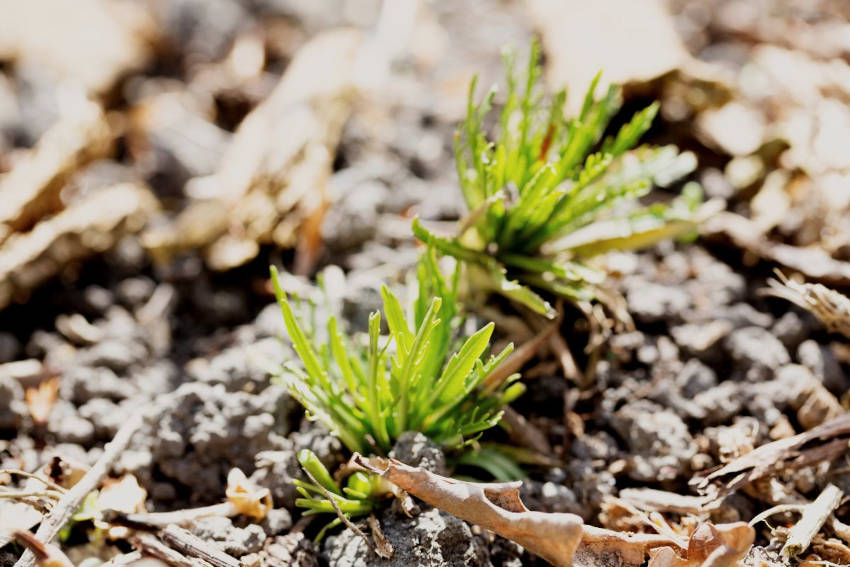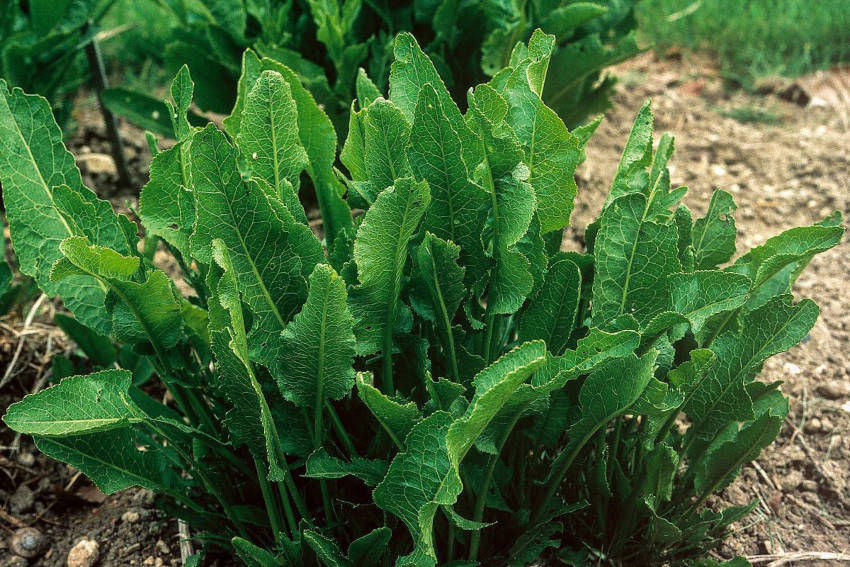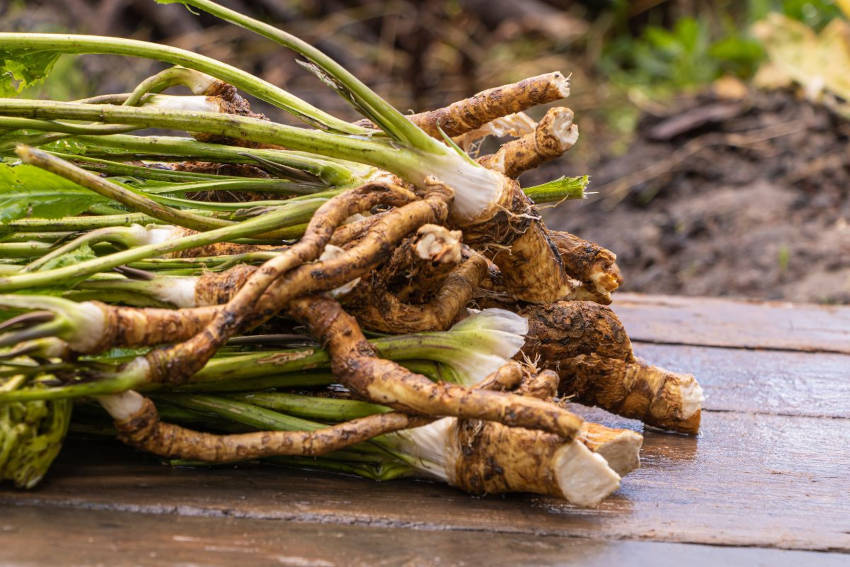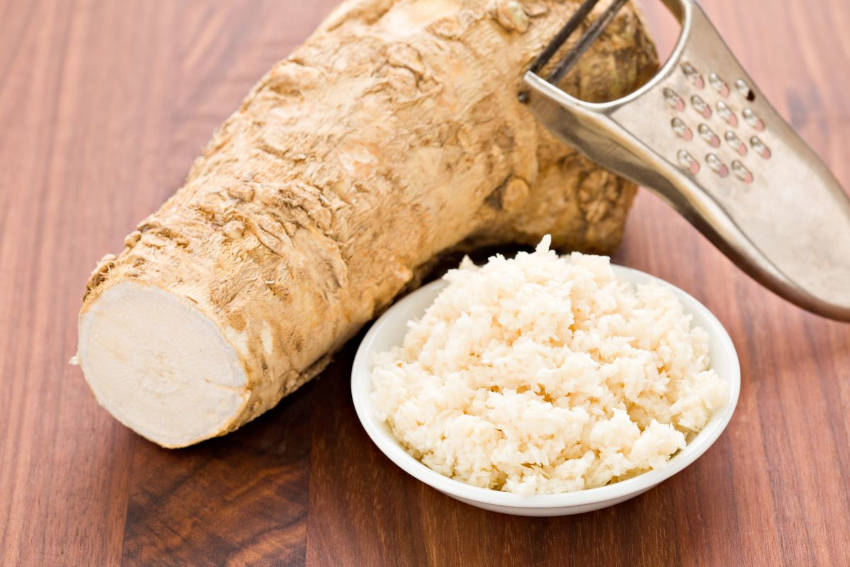Most people are familiar with horseradish’s hot and intensely spicy flavour, famously used in a creamy condiment accompanying that most English of meals, roast beef. Surprisingly, the bright green paste accompanying your serve of sushi may also be horseradish in disguise. Horseradish is often mixed with mustard and food colouring to replicate wasabi, which has a similar spicy flavour but is a more expensive and difficult crop to grow.
Fresh or pickled horseradish provides a pungent burst of flavour that can bring tears to the eyes. This may give the impression that horseradish is exotic or difficult to cultivate. In fact, horseradish is an easy crop to grow in the home vegetable garden - so easy that it can become a permanent fixture if care isn’t taken to grow it in a contained area.
What is Horseradish?
Horseradish (Armoracia rusticana) is a herbaceous perennial from the brassica family, meaning it’s related to mustard and radish. Plants have large basal leaves that grow up to 90cm tall. The large white to cream tap roots, which can grow up to 60cm long and 5cm wide, are the part of the plant that’s harvested and eaten.
Horseradish is a spice with a long history of cultivation, originally grown for its health and medicinal benefits. Because of its deep tap root, horseradish can also be used as a nutrient cycler and to break up compacted soil.
Plants will grow vigorously in temperate climates and can be productive in subtropical areas, but are not recommended for tropical zones.
How to Grow Horseradish
Preparation
Choose a permanent position in the garden. New plants will grow from the smallest of root fragments; it’s far preferable for new plants to pop up in a permanent, dedicated space than in other areas of the garden where they can be difficult to eradicate. If you’re concerned about invasiveness, bury a bottomless bucket or garbage bin in the garden bed to plant into; the roots will be confined to the growing space within the container.
Horseradish grows best in full sun to part shade in rich, well-drained soil. Adding some compost or aged manure will get the plants off to a good start. Dig over the soil so it’s friable and the roots can grow freely.
Horseradish can also be grown in a deep container such as a large grow bag or half wine barrel. Make sure the pot is deep enough to accommodate a large tap root and fill it with good quality potting mix, or a combination of potting mix and coarse sand or compost.
How to Plant Horseradish Root
Plant root fragments from late winter through to spring. Make a shallow trench around 3cm deep and place the root horizontally in the trench - if there is already growth on the root, place it so the shoots are pointing up so they can easily find their way to the surface. Cover with soil and water in well. Space roots 30cm apart and keep the soil moist until the first leaves appear.
Cultivation
Horseradish roots will be larger and more succulent if plants are well cared for and their growth is not ‘checked’. When the first leaves are around 10cm tall apply a handful of blood and bone around the base of the plant to encourage vigorous growth. Water deeply over the summer months to ensure the soil is kept evenly moist.
Plants will grow vigorously from spring to autumn then die back in winter, a signal that it’s time to harvest or divide the crop.
How to Harvest the Roots
Dig up the roots anytime from autumn to spring, keeping the largest to eat and replanting the smaller ones and any side shoots for next season. Use a garden fork to gently lift the whole plant from the ground, making sure to remove all small side roots if you don’t want new plants to emerge next spring. Roots grown from small root fragments or under less than ideal conditions may take two years to reach a harvestable size.
Pests and Diseases
Like other brassicas horseradish can be targeted by cabbage moths and cabbage white butterflies. A few holes in the leaves are nothing to worry about but if the damage is severe the plant’s productivity will be reduced and appropriate action should be taken to control the pests.
Horseradish in the Kitchen
Horseradish is usually peeled and then grated or chopped to be added to sauces, vinegars or pickles. Take care when peeling or grating the roots as the pungent fumes released are stronger than those from onions. Some people recommend preparing the roots outdoors to allow the fumes to dissipate in the open. If the roots have tough cores, discard the woody centres and grate the rest of the flesh as usual.
The roots will loose flavour quickly once grated; to preserve the heat and spiciness add vinegar two to three minutes after grating the root. Whole roots can be stored in the fridge for about two weeks, or grated horseradish can be combined with vinegar as a preservative or frozen for longer term storage.
Horseradish is often served as an accompaniment to roast beef, fish, tomato and egg dishes. It’s also the main flavouring in horseradish sauce and horseradish cream, where it is combined with lemon juice, chives, seasoning and sour cream to make a hot and tangy condiment.
Horseradish is an easy to grow root vegetable that will add spice to your kitchen garden.









